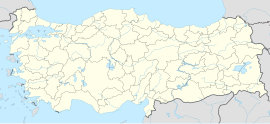Andaç (Kurdish: Elemûna;[2] Syriac: Halmūn)[3][nb 1] is a village in the Uludere District of Şırnak Province in Turkey.[5] The village is populated by Kurds from the Kaşuran tribe and had a population of 3,386 in 2023.[2][1]
Andaç | |
|---|---|
 Village | |
| Coordinates: 37°21′22″N 43°15′47″E / 37.356°N 43.263°E | |
| Country | Turkey |
| Province | Şırnak |
| District | Uludere |
| Population (2023)[1] | 3,386 |
| Time zone | UTC+3 (TRT) |
The hamlets of Arslanlı (Şivrezan) and Yarma (Gelemus, Geramûsa) are attached to Andaç.[5]
History
editHalmūn (today called Andaç) was historically inhabited by Assyrian people and located in the Lower Tyari district in the Hakkari region.[6] It is identified with the village of Halmon recorded in the diocese of Beth Nuhadra.[3] It had one church and was served as part of the diocese of the Patriarch of the Church of the East.[7] According to the English missionary George Percy Badger, the village was inhabited by 50 Assyrian families in 1850, all of whom belonged to the Church of the East and were served by two priests.[6] By 1877, the village's population had grown to 60 families with one priest when visited by Edward Lewes Cutts.[8] Halmūn was destroyed by the Ottoman Army in June 1915 amidst the Sayfo.[9] Survivors were later resettled at Cham Sus in Iraq.[10]
Population
editPopulation history from 2007 to 2023:[1]
| Year | Pop. | ±% |
|---|---|---|
| 2007 | 2,504 | — |
| 2010 | 2,797 | +11.7% |
| 2015 | 3,763 | +34.5% |
| 2020 | 2,639 | −29.9% |
| 2023 | 3,386 | +28.3% |
References
editNotes
Citations
- ^ a b c "Population Of Municipalities, Villages And Quarters". TÜİK. Retrieved 10 May 2024.
- ^ a b Baz (2016), p. 104.
- ^ a b Wilmshurst (2000), p. 277.
- ^ Badger (1852), p. 394; Aboona (2008), p. 291; Yacoub (2016), p. 166; Stafford (1935), p. 41.
- ^ a b "Türkiye Mülki İdare Bölümleri Envanteri". T.C. İçişleri Bakanlığı (in Turkish). Retrieved 19 December 2022.
- ^ a b Wilmshurst (2000), p. 288.
- ^ Wilmshurst (2000), p. 288; Aboona (2008), p. 288.
- ^ Wilmshurst (2000), p. 291.
- ^ Yacoub (2016), p. 166.
- ^ Stafford (1935), p. 41.
Bibliography
edit- Aboona, Hirmis (2008). Assyrians, Kurds, and Ottomans: Intercommunal Relations on the Periphery of the Ottoman Empire. Cambria Press. Retrieved 27 August 2020.
- Badger, George Percy (1852). The Nestorians and Their Rituals: With the Narrative of a Mission to Mesopotamia and Coordistan in 1842-1844, and of a Late Visit to Those Countries in 1850; Also, Researches Into the Present Condition of the Syrian Jacobites, Papal Syrians, and Chaldeans, and an Inquiry Into the Religious Tenets of the Yezeedees. Vol. 1. Retrieved 21 December 2022.
- Baz, Ibrahim (2016). Şırnak aşiretleri ve kültürü (in Turkish). ISBN 9786058849631.
- Stafford, Ronald Sempill (1935). The Tragedy of the Assyrians (PDF). Retrieved 21 December 2022.
- Wilmshurst, David (2000). The Ecclesiastical Organisation of the Church of the East, 1318–1913 (PDF). Peeters Publishers. Retrieved 30 October 2024.
- Yacoub, Joseph (2016). Year of the Sword: The Assyrian Christian Genocide, A History. Translated by James Ferguson. Oxford University Press.
